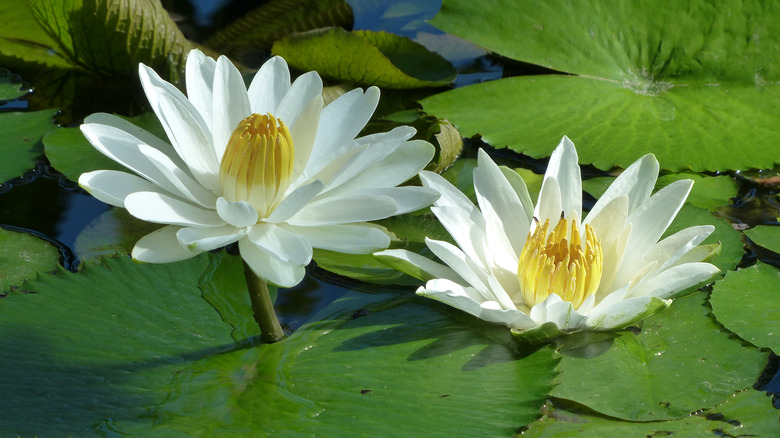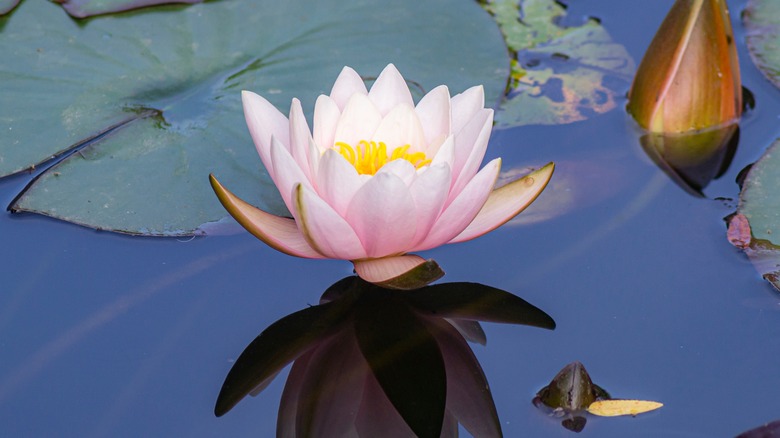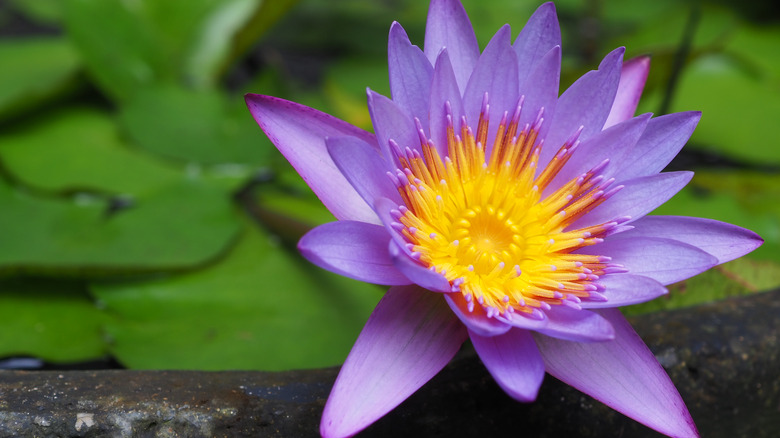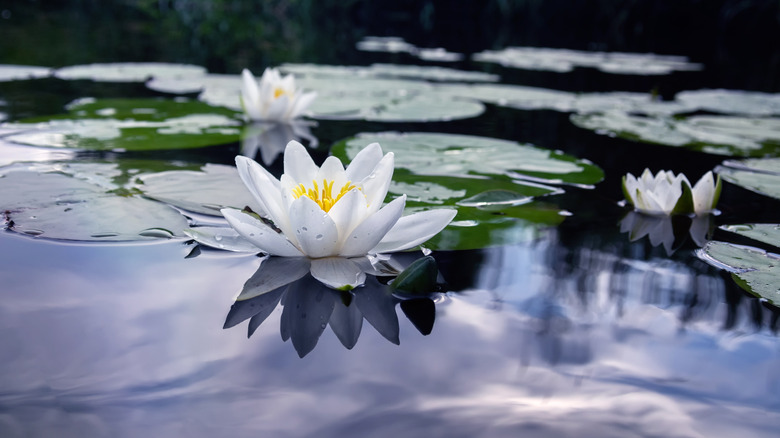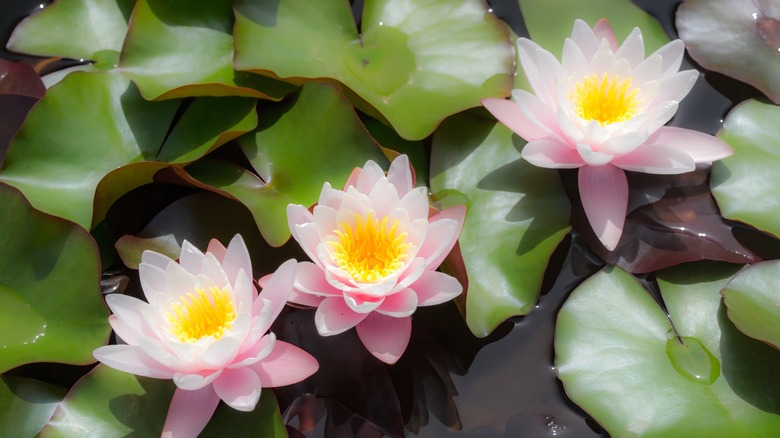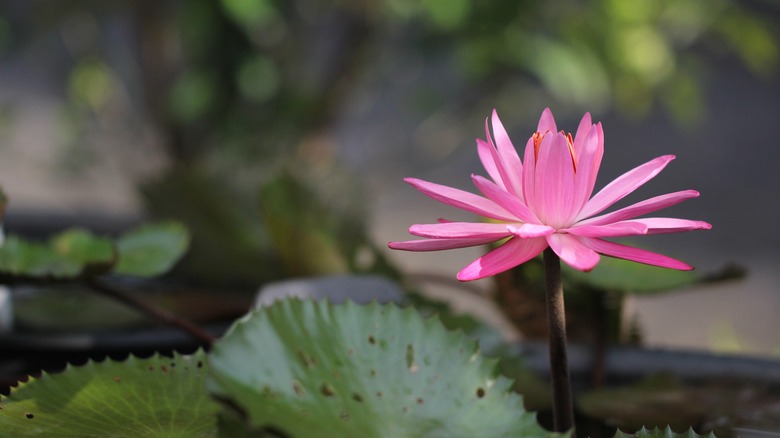Water Lilies: Everything You Should Know Before Planting
Ponds are an excellent landscaping addition to your home, adding a beautiful touch of nature and serenity. Ponds are also a great option for those wanting to stimulate the biodiversity and wildlife population in their area, similar to pollinator gardens. According to Pond Informer, ponds aren't just defined as a certain sized body of water, but instead as a body of water that supports local wildlife and biodiversity including fish, amphibians, insects, and plants.
One popular plant to add to your pond are water lilies (nymphaeaceae). If you've ever seen a lush, full blooming pond in the summer or fall, you've seen water lilies. They very closely resemble lotus flowers, but are not the same. Water lilies come in a variety of sizes and colors, and not all of them require a large body of water to grow. One thing they all have in common, though, is growing in watery habitats.
How to use in garden
While water lilies add a sense of elegance and beauty to your pond, they are also practical and necessary. As Merebrook Pond Plants notes, ponds benefit from being covered by plants in the summer — at least 1/3 to 1/2 of the water's surface. This is to control blanket weed, also known as string algae or silkweed. According to Envii, this pond weed not only looks bad, but can harm fish, deprive ponds of oxygen, and create chemical imbalances.
Since blanket weed thrives in lots of light, the easiest way to prevent it from growing out of control is to add surface plants, like water lilies! Not only do water lilies keep pond weeds from spreading, but they also provide shade and shelter to wildlife, including snails, frogs, and fish.
When deciding what type of lily to plant in your pond, Masterclass says you should decide based on your climate. Those living in USDA hardiness zones 3 through 11 should opt for hardy water lilies, and people in zones 10 through 11 should opt for tropical flowering lilies. As long as you're covering enough of the surface, you can combine any number of sizes, colors, and cultivars. You can also combine them with other pond plants, like water lettuce, water hyacinth, sweet flag, and more (via Aquascape).
How to grow water lilies
Water lilies are easily found at garden centers just before and throughout the summer months. However, the cost of pond plants can quickly add up. For this reason, you may want to know how to propagate your water lilies.
According to BBC Gardening, water lilies can be propagated by division of the roots, which are tuberous rhizomes. As the plant grows, the root system will produce small offshoots. Once those offshoots are large enough, you can separate them from the main plant and replant. You should do this in the early spring before the plant starts to flower, but while there are enough visible offshoots.
Begin by removing the plant from the water and laying it on some plastic or a sheet. Use sharp and clean shears to cut off the new growth. Grab a basket or pot and line it with a burlap bag, and then add a thin layer of soil. Be sure to use aquatic soil, as garden soil can encourage algae growth which will stunt growth. Add the propagation, keeping the shoots at the surface, and fill the rest of the way with soil. Fold the bag on top of the soil and add grit, which will help keep the plant in place. Then, place the pot in shallow water with lots of sunlight. Move to deeper water in the summer as the flowers begin to emerge.
How to care for water lilies
Water lilies are generally very hardy and are incredibly low-maintenance plants once established in your pond. However, there are some things you need to keep in mind when tending to young plants and even mature plants. Water lilies need to be planted in full sun for both their own growth and to suppress the growth of algae, explains Love the Garden. They should also be planted in neutral, loamy soil, which will usually be added to a pot as opposed to the base of the pond.
Water lilies are also quite hungry flowers, which makes them ideal for ponds where they can consume debris and help balance the ecosystem. However, it isn't a bad idea to help supplement their appetite, especially for optimally vibrant blooms. In this case, you can add a slow-release, aquatic, plant-specific fertilizer once at the beginning of the growing season. Finally, for both the aesthetic and health of the pond, you should cut off and remove any dead or yellowing leaves, as well as fading and dying flowers.
Water lily varieties
According to Masterclass, there are more than 50 identified species of water lilies and even more cultivars within those varieties. These varieties and cultivars offer different flower shapes, sizes, and colors. Many of these can be planted together, creating gorgeous, colorful, and diverse pond scapes. Here are just a few of those varieties (via Trees.com):
-
Nymphaea Pygmaea Rubra — This water lily variety is hardy and gorgeous. The dwarf flower offers bright pink and purple-tipped, cupped petals and grows small lily pads alongside them.
-
Nymphaea alba — Also known as the white water rose, this is one of the most popular varieties and grows stunning white flowers with lily pads that average 1 foot in diameter.
-
Nymphaea Pygmaea Helvola — This is an incredibly small dwarf variety, with the sift yellow flowers often only growing 2 inches in diameter. They only grow in shallow waters.
-
Nymphaea gigantea — This variety is also referred to as blue cloud due to its large and full blue flowers. This is a rather large variety, with leaves growing up to 2.5 feet in diameter.
-
Nymphaea capensis — This variety, also known as blue water lily is unique for being drought resistant, the purple and blue blooms being native to dry river beds.
How to repot water lilies
Planting water lilies may seem like a daunting task due to their growing conditions, but it's quite simple and doesn't involve you having to spend too much time in your pond. Water lilies are actually best grown in containers or pots, which allows you to easily uproot them to investigate diseases or separate them. This also benefits the pond's health, as the plant can sometimes grow too thick if planted in-ground and kill the plants and wildlife underneath, warns Masterclass.
Begin planting your water lilies by preparing a 2.5-gallon container and, optionally, line with burlap (via Merebrook Pond Plants). As for soil, you should either use a good quality garden loam or aquatic soil, but you should never use anything peat-based. Fill your container about 1/4 of the way, and then add your water lily. Hold it so the rhizomes are even with the surface, and the offshoots are above.
Fill the container the rest of the way with your soil. If you planted it with burlap, fold the burlap over. Burlap or not, add some pea gravel or grit on top, which will help keep the plant from drifting out in the water. Now, add the container to your pond. How deep you plant it will depend on your variety, but you should never submerge it more than 18 inches deep. You can use rocks to elevate the container in deeper ponds.
